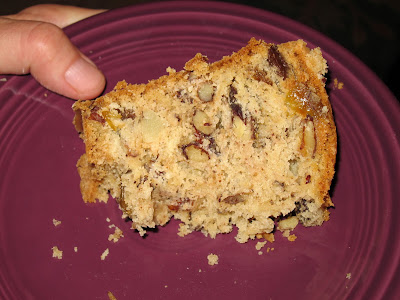



Wine: Schloss Muhlenhof 2008 Muller-Throcken
The Prisoner 2007 Napa Valley Red Wine
Chateau Dassault 2005 Grand Cru Classe
Les Hauts Lastour 2006 Coteaux du Quercy
We ate at Palate and Jason had made an excellent Lemon Roast Veal with Rosemary based upon a recipe in a Lynne Rossetto Kasper “The Splendid Table”, a cookbook that we had given him for Christmas. We decided to make it ourselves.
It turned out to be quite a project to find a bone-in veal roast. Luckily, Bea had sent us a notice that a new butcher shop: McCall’s Meat and Fish had recently opened near us. We drove over, and checked it out. It is small but has an excellent selection. Once we decided to make the veal, we called them and ordered the veal. When we finally picked it up, it was a beautiful peace of meat.
We followed the recipe, rifting off of Jason’s adaptation. We added lucques olives and preserved lemon peel to the sauce at the end, as Jason had.
Kevin started the meal by making a Salad with Pears, Gorgonzola Cheese and Walnuts.
We also made Mashed Potatoes from a recipe in the cookbook: The Café Zuni Cookbook.
For dessert we had left over Birthday Cake from Barbara’s birthday dinner that we had frozen. It was excellent. We are grateful that Barbara didn’t want to take the cake back to San Francisco with her!
Lemon Roast Veal with Rosemary
Vitello al Forno
Lynne Rossetto Kasper “The Splendid Table”
Scented with lemon and herbs, this veal roast gains extra succulence from a fine mincing of pancetta, Tucked into slits in the roast, it flavors and moistens the meat as it cooks. Some Emilia-Romagna cooks baste the veal with milk, hut I prefer the equally traditional hasting of white wine and the unusual finishing
touch of fresh lemon, a favorite trick of a Modena friend Moist veal is
guaranteed by taking the meat only to the rosy stage. In Italy it would be more well done, a style that is delicious there hut turns dry when done with most American veal.
Serves 6 to 8
3 to 4 pounds boneless loin of veal
2 ounces pancetta, minced
1 large clove garlic, minced
1/4 cup minced Italian parsley
2 tablespoons fresh lemon juice
2 tablespoons extra-virgin olive
Salt and freshly ground black pepper
3-inch sprig fresh rosemary, or 1teaspoon dried rosemary leaves
2/3 cup dry White Wine
1/2 cup Poultry/Meat Stock
Rosemary sprigs for garnish
Method
Working Ahead: For the best flavor, season the roast pancetta mixture 1
day abead. Refrigerate it, lightly covered, until about 1 hoar before roasting. The roast is best eaten as soon as cooking is completed.
Seasoning the Veal: Mince together the pancetta, garlic, and parsley. Turn into
a bowl, stirring in 1 tablespoon of the lemon juice. Using a paring knife, make 15 or 16 deep slits into the roast, over its entire surface. Using your fingers, stuff the seasoning mixture into each slit. Set the roast on a platter, cover lightly with wrap, and refrigerate 24 hours.
Roasting the Veal: Preheat the oven to 350 Rub the veal with the olive oil and sprinkle lightly with salt and pepper. Set it in a shallow pan with the rosemary. The roast will take about 25 minutes to the pound (1-1/4 to 1-3/4 hours).
Roast 20 minutes, then pour half the wine over the meat, basting with the pan juices. Continue roasting, basting and adding small amounts of wine, until an instant-reading thermometer inserted in the meat’s center reads 150 F. Remove the roast to a warm platter and keep warm.
Making the Sauce: Skim the fat from the pan juices. Set the roasting pan on
a burner over high heat. Bring the juices t a boil, stirring in the stock. Boil, scraping up the brown glaze in the pan with a wooden spatula, 2 minutes, or until the sauce has thickened slightly and is full-flavored. Season with salt and pepper, and stir in the remaining 1-tablespoon of lemon juice.
Serving: Keep the sauce warm as you carve the meat into 1/4 -inch-thick slices.
Garnish the platter with a few sprigs of rosemary, and pass the sauce separately.


















